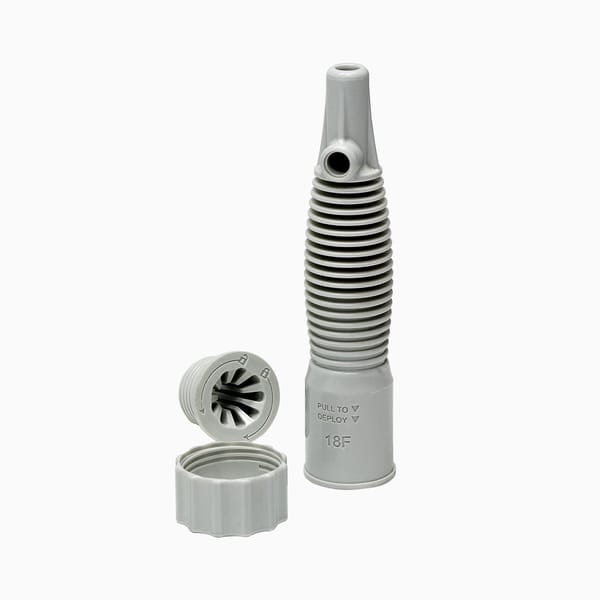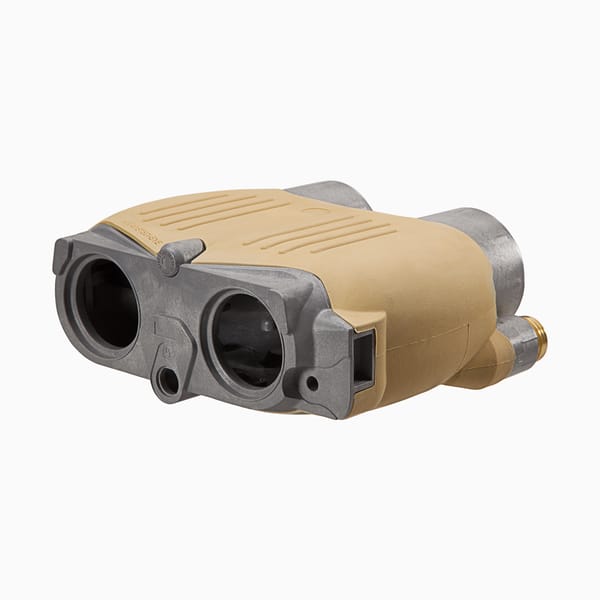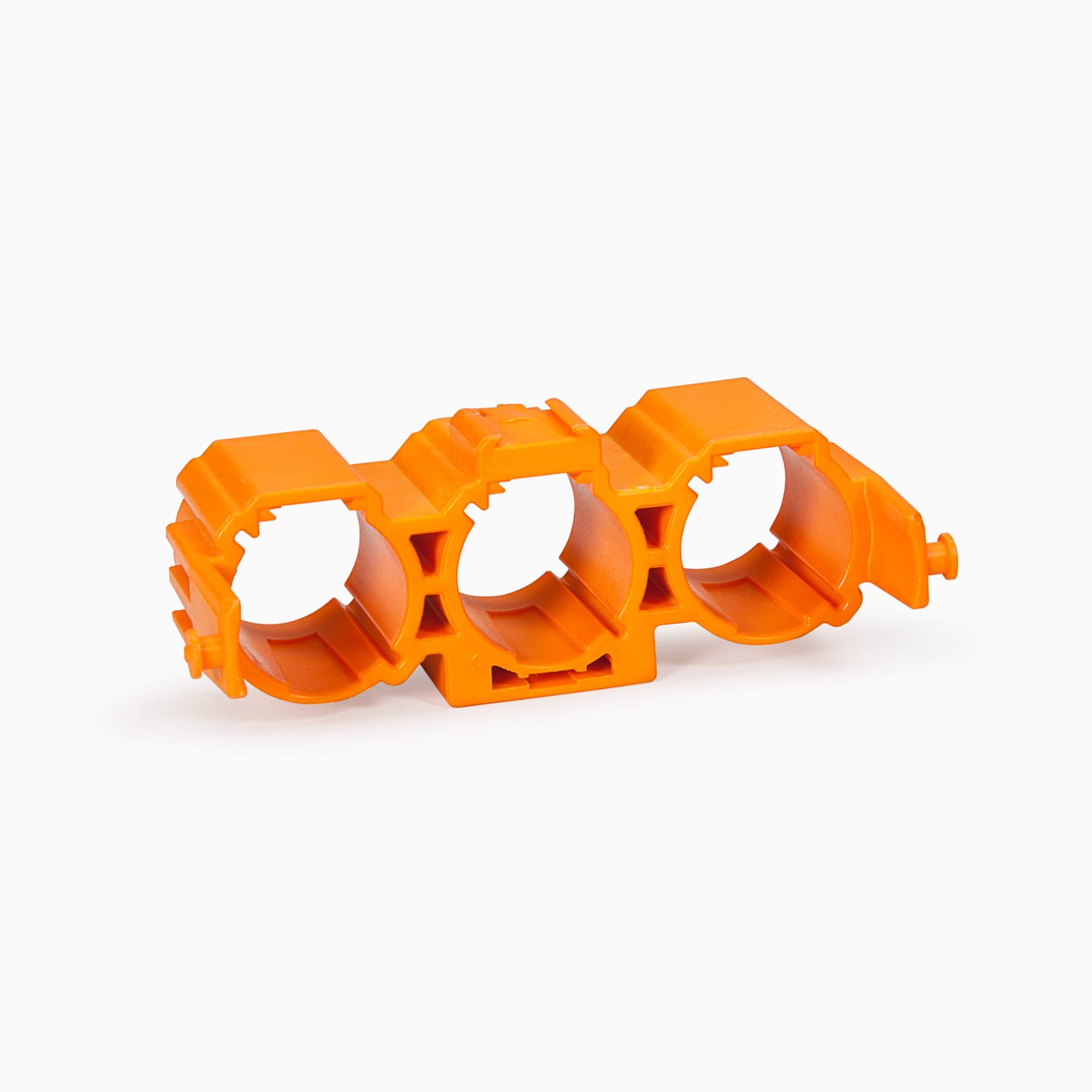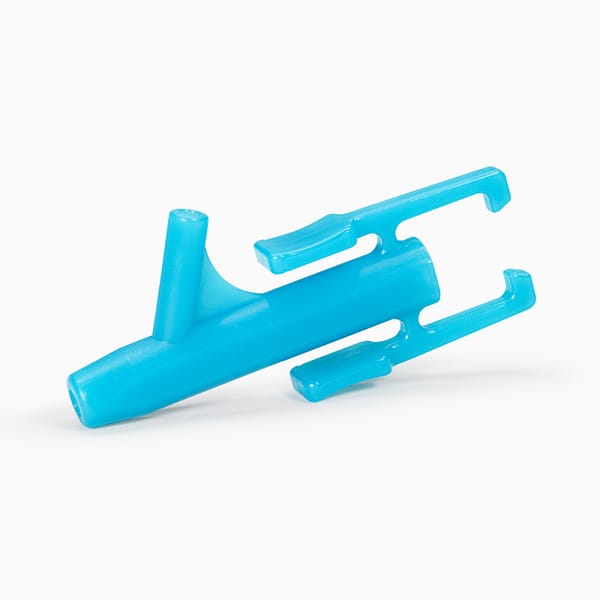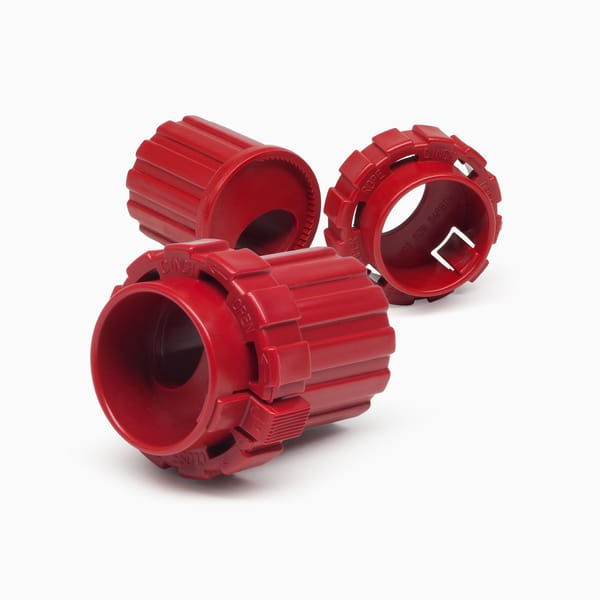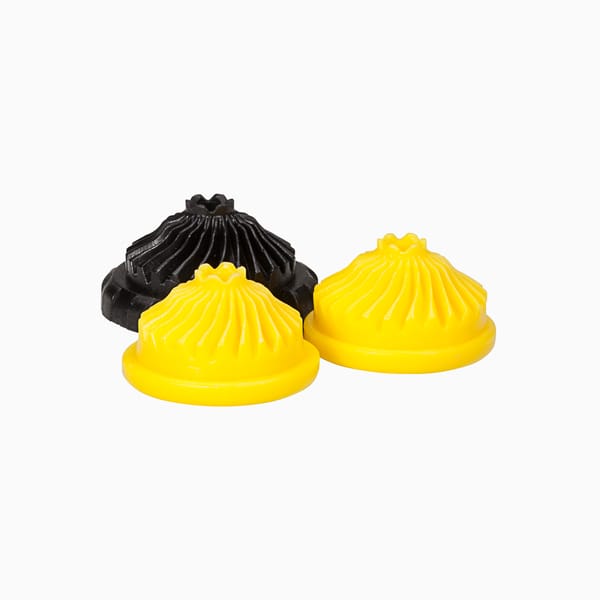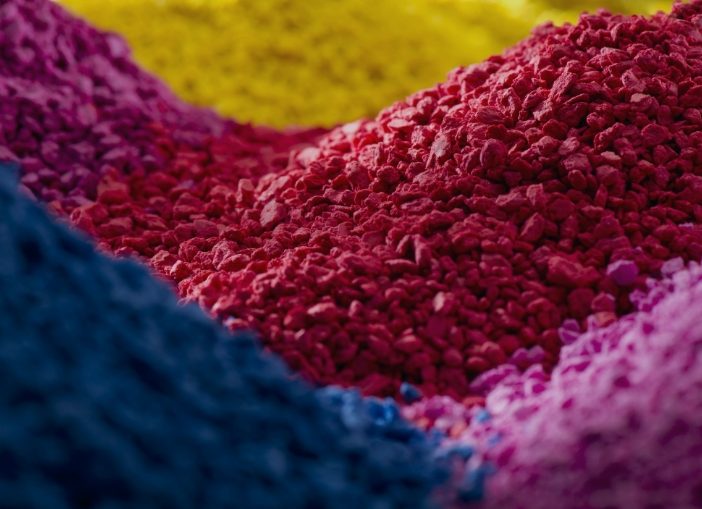
Material selection is critical for designing and developing robust and long-lasting products.
However, with over hundreds of plastic resins on the market to choose from, each with its unique properties, advantages, and disadvantages, it’s easy to feel overwhelmed when trying to select the right material for your project.
But fear not: Xcentric’s team of material experts are here to help!
We have extensive experience working with plastic resins, and we understand how different properties can impact your parts—during and after production.
If you’re looking for the best plastic resins for injection molding, here are six common options to consider:
- Acrylonitrile Butadiene Styrene (ABS)
- Polycarbonate (PC)
- Polycarbonate-ABS (PC/ABS)
- Polypropylene (PP)
- Nylon
- Acetal, or Polyoxymethylene (POM)
Below, we explore the characteristics, pros, and cons of these six common injection molding plastic resins. Read on to learn more about each material.
You can also download this quick guide as a handy offline reference.
1. ABS: Acrylonitrile Butadiene Styrene
As far as plastic resins go, ABS is by far one of the most popular and versatile materials. It is an affordable, highly moldable engineering plastic with mechanical and electrical properties, making it one of the most widely used thermoplastics in the world.
With ABS injection molding, you get the collective benefits and properties of three monomers. It combines the strength and rigidity of acrylonitrile and styrene polymers with the toughness of polybutadiene to deliver superior hardness and toughness.
In addition, ABS provides a colorfast, high-gloss surface finish. And to top it all off, this plastic resin has excellent stress, impact, creep, and heat resistance. It can be heated, cooled, and re-heated without changing its characteristics.
Common applications include:
- Small appliances
- Medical devices
- Enclosures for electronics and electronic assemblies
- Office equipment
- Toys
Design Considerations of ABS Plastic
Parts molded with ABS are susceptible to forming knit lines, which are visible lines on the surface of the part. One solution is to use optimal wall thickness to help slow cooling during the ABS plastic molding process. The recommended wall thickness for this material is 0.045–0.140 inches.
Medical part molded using ABS plastic resin (from Xcentric’s Parts Gallery)
Advantages and Disadvantages of ABS Plastic Resins
Take a look at the pros and cons of ABS molding to make an informed decision for your product design.
Advantages of ABS Plastic
- Structural/dimensional stability
- High impact resistance
- High rigidity and strength
- Heat and chemical resistance
- Abrasion and stain resistance
- Surface brightness and high-gloss finish
Disadvantages of ABS Plastic
- Maximum continuous use temperature of approximately 70° C (160° F)
- Poor solvent and fatigue resistance
- Poor UV resistance unless protected
- Poor bearing properties (high friction and wear)
- High smoke evolution
2. PC: Polycarbonate
PC polymers are amorphous engineering thermoplastics with a toughness down to -20° C. They are naturally transparent and can transmit over 90% of light as good as glass.
Because of these properties, polycarbonate resins are often used as a light-weight alternative to glass. PC is also a good choice for high-impact resistance requirements.
Some applications include:
- Bullet-proof glass
- Medical device components
- Light fixtures
- Green houses
In addition, PC is a natural UV filter, which makes it an optimal material for eyewear.
Another feature of PC is its pliability. In fact, it can often be processed at room temperature without breaking or cracking. This property makes it a popular material for prototyping, especially when transparency is required.
Design Considerations of PC Plastic
Although it provides outstanding impact resistance, polycarbonate is susceptible to scratching. Therefore, for applications where this will be an issue, consider adding a scratch-resistant coating.
Binoculars injection molded with PC for the military (from Xcentric’s Parts Gallery)
Advantages and Disadvantages of PC Plastic Resins
While PC is a popular plastic that provides product designers more flexibility in their part designs, there are still a few disadvantages that may eliminate it from your material selection process. Here are some pros and cons of PC injection molding to consider.
Advantages of PC Plastic
- High impact strength and toughness down to -20°C
- Naturally transparent (can transmit over 90% of light as good as glass)
- Can be designed with 100% protection from harmful UV rays
- High dimensional stability
- Pliable at room temperature without breaking or cracking (good for prototyping)
- Good heat resistance and thermally stable up to 135°C
Disadvantages of PC Plastic
- Susceptible to scratching despite its resistance to high impact
- Considered hazardous for food with the release of Bisphenol A (BPA)
3. PC/ABS: Polycarbonate-ABS
PC/ABS is one of the most widely used industrial-grade thermoplastics. It is a high-impact engineering polymer that combines the strength and heat resistance of polycarbonate with the flexibility and high-quality surface finish of ABS. This material also provides improved processing during the injection molding process.
Product designers and engineers often choose PC/ABS plastic for functional prototyping, tooling, and low-volume manufacturing. This is because PC/ABS is likely to provide stronger parts and prototypes that mimic the material properties of the final product.
Common applications include:
- Automotive exterior and interior components
- Business equipment housings and enclosures
- Medical hardware
- Electrical housings
- Computers
- Monitors
Design Considerations of PC/ABS Plastic
While PC/ABS is extremely versatile and offers improved strength over ABS at a lower cost than polycarbonate, it has poor UV and fatigue endurance. Nonetheless, you can modify it by adding reinforcing agents such as glass fiber, mineral fillers, and flame retardants.
Custom-colored plastic battery housings molded with PC/ABS (from Xcentric’s Parts Gallery)
Advantages and Disadvantages of PC/ABS Plastic Resins
Although PC/ABS can provide the best properties of two polymers, it is critical to understand its key pros and cons to ensure it is right for your fit, form, and function.
Advantages of PC/ABS Plastic
- High impact strength, even at low temperatures
- Good heat resistance
- High stiffness
- Easy processing
- Low overall shrinkage and high dimensional accuracy
Disadvantages of PC/ABS Plastic
- Poor solvent resistance
- Low dielectric strength (not a good insulator)
- Low continuous service temperature (melts easily)
4. PP: Polypropylene
Polypropylene is a crystalline thermoplastic. It is tough, flexible, and provides outstanding heat and chemical resistance. It is also one of the cheapest plastic resins available and is used both as a plastic and a fiber.
Applications include:
- Automotive manufacturing
- Furniture assembly
- Textiles
- Aerospace components
- Medical devices and equipment
In addition, PP is a good option for special parts like living hinges.
Medical “y” body used in an IV tube system, molded with PP (from Xcentric’s Parts Gallery)
Design Considerations of PP Plastic
PP may be the cheapest resin, but that doesn’t mean it will always meet your requirements. For instance, if your part requires impact resistance properties, consider PC/ABS instead.
Advantages and Disadvantages of PP Plastic Resins
Polypropylene will likely be your cheapest option, but that doesn’t necessarily make it the best choice for plastic resin injection molding. In fact, selecting the wrong material can still add to your production costs in the end.
Instead, consider these pros and cons of using polypropylene before making a material selection.
Advantages of PP Plastic
- Excellent moisture resistance
- High stiffness and impact strength
- Good heat and chemical resistance
- High dielectric strength
- Food grades available
- Easy processing
Disadvantages of PP Plastic
- Poor resistance to chlorinated solvents
- Susceptible to UV-light degradation
- Flammable (retarded grades available)
5. Nylon
Nylon is a semi-crystalline polyamide with low density and high thermal stability. Polyamides (nylon) are a group of technical thermoplastics with properties that range from the hard and tough PA 66 to the soft and flexible PA 12.
In general, nylon plastic resins provide fantastic wear resistance, good coefficient of friction, and very good temperature and impact properties. Furthermore, nylon has excellent chemical resistance and has proven to be a good oil-resistant plastic.
This balance of properties makes nylon a good candidate for metal replacement in some applications that require toughness and weight reduction, such as automotive parts and industrial components.
Design Considerations of Nylon Plastic
Nylon absorbs water. So, if your part will be exposed to moisture, nylon may not be the ideal plastic to use because its dimensional and structural integrity may be damaged.
Nylon plastic is also prone to shrinkage when it is being molded—which can lead to diminished strength, color issues, and bent edges—but controlling the heat and molding temperatures may help reduce shrinkage.
Rope cinch produced using nylon (from Xcentric’s Parts Gallery)
Advantages and Disadvantages of Nylon
Nylon is easy to process and can be a cost-effective solution for your project. But like all other plastic injection molding resins on our list, it’s important to first understand how its properties will impact your design intent before making your choice.
Advantages of Nylon Plastic
- Excellent abrasion and wear resistance
- High tensile and compressive strength
- Low coefficient of friction
- Lightweight option (at 1/7th the weight of conventional materials)
- Easy to machine
Disadvantages of Nylon Plastic
- High shrinkage in molded sections
- Lack of stability
- Prone to absorbing moisture (reduces strength and stiffness properties)
6. POM: Polyoxymethylene (Acetal)
POM, also known as acetal, is a naturally white semi-crystalline engineering thermoplastic and is characterized by its high rigidity to −40° C. It is used in the injection molding process to produce parts that require high precision, stiffness, and low friction. It has excellent dimensional stability and resistance to abrasion, heat, water absorption, and creep.
Because of its low coefficient of friction, POM is good material choice for producing high-performance engineering components, medical equipment, and electrical housings. By nature, POM is a slippery material, which makes it a good fit for products that require sliding mechanisms and gears.
It is important to note, however, that POM has a very high shrink rate of about 2%.
Design Considerations of POM Plastic
If you are designing parts that have large variations in wall thicknesses, POM can be dimensionally unstable. Large parts molded with POM are more likely to experience warping than smaller parts. Therefore, consider adding fillets or ribs to strengthen the part.
Sprinkler components for agriculture, produced using acetal (from Xcentric’s Parts Gallery)
Advantages and Disadvantages of POM Plastic Resins
POM is one of the most common plastics used for injection molding. Here are some of its pros and cons to help you determine whether POM is right for achieving your design intent.
Advantages of POM Plastic
- High strength
- Rigidity to -40° C
- High resistance to impact, creep, abrasion, and solvent
- Good fatigue endurance and low coefficient of friction
Disadvantages of POM Plastic
- High shrinkage of about 2%
- Very poor resistance to UV radiation
- Poor resistance to acids/alkalis
- Flammable and not available with flame retardants
Quick Guide: 6 Common Plastics for Injection Molding
Here’s a free guide with a quick overview of these six plastic materials. Download it now for easy use offline.
Get to Market at Speed with the Right Plastic
If you’re struggling to find the right plastic resin for your part design, don’t be discouraged. Talking to a material selection expert from Xcentric can help you decide and bring your ideas to life faster and on budget.
Xcentric will:
✔ Help you choose from a range of plastic material options.
✔ Guide you in evaluating these material options based on your application needs.
✔ Work to best practices to ensure you deliver your product to market successfully.
Sounds like what you need? Submit your project and our team will be happy to provide expert advice
About Xcentric
Founded in 1996, Xcentric Mold & Engineering is an innovator of on-demand digital manufacturing and continues to lead advances in injection molding and rapid prototyping. We know what it takes to deliver a high quality product on time and on budget. Xcentric is engineered to be nimble, employs a team of experts in injection molding, and takes an engineer centric approach to everything we do. Tens of thousands of product developers and engineers across North America trust Xcentric to bring their products to life.
Learn more about what Xcentric can do for you here.
Questions? Contact our friendly sales team here or on 586-598-4636.

